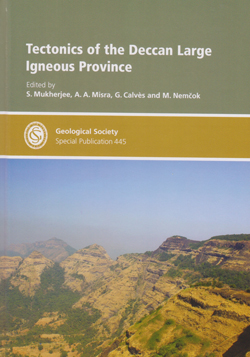Tectonics of the Deccan Large Igneous Province

The Deccan Traps of India are the product of the voluminous outpouring of basaltic lavas at the Cretaceous-Tertiary boundary and are among the best studied of all the Worlds’ large igneous provinces (LIPs). These traps were an early focus for many petrologists who undertook seminal work on basalt geochemistry. They have been used to develop models of plateau uplift, the nature of mantle plumes and the effect of asteroid impacts, as well as the cause of the resulting mass extinctions. The well-known Geological Survey of India two-volume memoir on the Deccan Volcanic Province (1999) stood for two decades as the reference work. You may be forgiven for thinking that there was nothing new that could possibly be written on the geology of the Deccan LIPs.
You’d be wrong. Soumyajit Mukherjee and his co-editors have successfully compiled a book that provides fresh insights into an understanding of the tectonics of the Deccan LIP. The volume nicely brings together the results of modern fieldwork, offshore geophysical data with onshore seismic and gravity data, subsidence with uplift studies, and neotectonics. The book contains original 13 articles and an introduction by the editors.
India, Madagascar and the Seychelles were a single continental plate until the Late Cretaceous, when first Madagascar separated from India, followed by rifting of the Seychelles micro-continent and the Laxmi Ridge, at around 63 million years ago. This latter rifting event was coeval with Deccan flood volcanism and thus opens the continuing debate as to whether the cause of the Deccan LIP is a mantle plume or rifting processes.
The papers in this volume provide new insights into the tectonic evolution of the Deccan LIP. Kale et al. show that the traditional view of the Deccan as structurally simple is incorrect by demonstrating the presence fault blocks with different uplift histories. Nemčok & Rybár beautifully illustrate the rift–drift break-up in the Gop Rift–Laxmi Basin that immediately predated the Deccan eruption and speculate on the role of the Réunion Plume in the tectonics of the LIP. Modern field structural mapping by Misra and Mukherjee documents the deformation histories of basaltic dykes to define a chronology of emplacement. Misra et al. record how post-rift subsidence on the ridges in the NW Arabian Sea drowned the Paleocene carbonates—important for offshore oil-and-gas exploration in both India and Pakistan.
This is a well-produced and edited volume effectively brings together diverse disciplines and topics. It will provide inspiration for future research on this geologically fascinating province, which I am sure has much still to reveal on the evolution of the Indian Ocean and LIPs.
Reviewed by Stuart Burley
TECTONICS OF THE DECCAN LARGE IGNEOUS PROVINCE, by S. Mukherjee, A. A. Misra, G. Calves & M. Nemčok (Eds) 2017. Geological Society of London SP 445, 363pp. (hbk). ISBN 978-1-78620-275-8
List Price: £110.00
Fellow’s Price: £55.00
W: https://www.geolsoc.org.uk/SP445